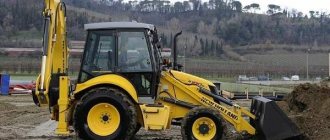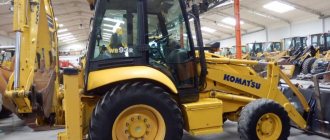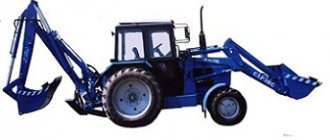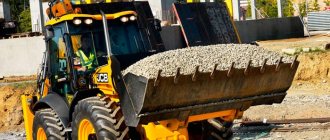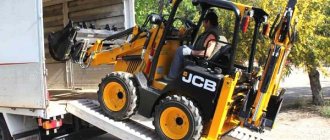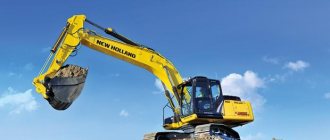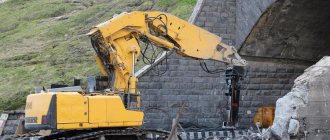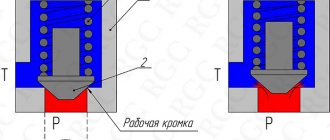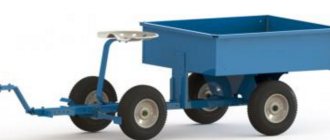Choosing a bucket balances between capacity, durability, functionality and cost. The most difficult thing is to understand which bucket is best to purchase for mixed operating conditions of special equipment, but first things first. An excavator bucket operates under multidirectional loads that tend to twist, bend, etc.
The thickness of the metal, reinforcements, number and size of teeth, and other parameters are calculated by the manufacturer so that the product can perform its function throughout its entire service life and not lose performance characteristics.
Bucket classes
For excavation, loading and unloading operations and working with rock or frozen rocks, you will need your own bucket, which has unique characteristics.
The following types of buckets are installed on excavators and loaders:
- Standard.
- Trench.
- Stripper.
- Planning.
- Crushing.
- Lattice.
- Overloader.
- Loading.
- Rocky.
- Reinforced.
- Profile.
- Single tooth ripper, etc.
What should you pay attention to? Looking for the perfect front loader
Front-end loaders with a main bucket capacity of 0.68-4.5 m³ and a lifting capacity of 0.75-7 tons are increasingly used in construction, municipal services and quarries, displacing single-bucket excavators and bulldozers in a number of technological operations.
Read: Introduction to Chinese technology: XIAGONG XG942 front loader
Front-end loaders are created on special wheeled chassis and have a single design with all drive wheels of the same size and an articulated frame with a half-frame folding angle in the range of 35-40°, with a rear-mounted engine (as a counterweight) and a front-mounted main bucket. The lifting boom is either a Z-shaped or parallelogram design.
The vehicles are equipped with both Russian engines (usually YaMZ) and foreign ones - medium-speed diesel engines with a high torque reserve factor, equipped with electronic fuel injection systems and meeting environmental requirements. Typically the use of a hydromechanical transmission with a 3- or 4-range planetary gearbox (or hydrostatic continuously variable transmission), a drive axle with a differential lock, a planetary wheel reduction gear, a rigid suspension of the front cargo axle and a balancer suspension of the rear axle. The cabin allows all-round visibility and is equipped with an adjustable seat, heating, ventilation, and noise absorption systems. The automated gear shifting and control system is designed for various operating modes selected by the operator depending on operating conditions.
Read
FOTON FL936FII loaders - quality proven over the years!
The main criteria when looking for a front loader are lifting capacity, bucket volume, price, fuel efficiency and performance, and at constant engine power, lifting capacity is determined by the capacity and purpose of the bucket. Light-weight equipment can be used in road construction work in cramped conditions. Medium front loaders usually perform site leveling, excavation, stripping and other excavation work. Heavy models are used in quarries and large open areas. All equipment copes well with bulk materials: sand, crushed stone, metal shavings, wood chips, agricultural products, etc.
When operating a front-end loader outside the city, its dimensions do not matter. To work in a populated area, it is worth purchasing a front loader that fits within the accepted overall dimensions for public roads: width up to 2.6 m and height up to 4 m.
In addition, it is advisable to take into account the possibility of changing the bucket and especially the ergonomics of the operator’s workplace. Operator comfort is no less important than the technical characteristics of the machine. Fatigue from noise, dust, inconvenient working parts, and uncomfortable temperature in the cabin reduces performance, neutralizing the technical advantages of the machine he controls.
Read
John Deere equipment: at the service of public utilities!
Like any equipment, a front loader requires periodic maintenance and inspection. The list of works includes: preventive inspection, replacement of technical fluids, frequency and need for adjustment, replacement of any components and consumables. It is very important that all documentation (operation manual, form, spare parts catalog) is in Russian, with all the necessary diagrams and pictures. Timely maintenance will prevent breakdowns and ensure maximum service life of the front loader.
Many factors contribute to the spread of front loaders:
- the ratio of the actual load capacity of a front loader to its weight is 2-2.5 times higher than that of hydraulic excavators;
- the specific cost of a wheeled front loader per 1 m³ of bucket capacity is 1.5-2 times lower than that of excavators;
- higher rates of mobility and maneuverability, allowing one machine to perform loading and transport work;
- comparability of the magnitudes of the breaking forces on the cutting edge of the bucket of a wheeled front loader and an excavator (with equal bucket capacity), although the loader is inferior to the excavator in implementing the breaking force over the entire height of the face;
- the similarity of the bucket filling coefficients of a front loader and an excavator, which is usually 0.75-0.8 (less often 1.0-1.1).
Look
All advertisements for the sale of front loaders
In addition to the technical characteristics of the machine, its cost is important. Today there are many front loaders of different brands from different countries on the market. Everyone chooses according to their pocket - some prefer proven equipment from the world's leading manufacturers for a lot of money, others prefer less expensive but little-known machines. As a rule, official distributors have lower prices than resellers. Next, it’s worth looking at the reliability of the equipment. This concept is quite subjective, but important. It’s worth asking how long the equipment has been on the market, talking to those who have already purchased it, what warranties are offered, etc. The selling company must have its own service center with prompt service and qualified specialists.
The main indicator of the reliability of the ChengGong brand is Caterpillar and Deutz engines. There have been cases where front loaders operated without interruption at temperatures of -38°C. If the car starts normally, then it works without any problems. Front loaders are equipped with a winter start function - when you press a button in the cab, an ether mixture is injected into the suction manifold, which softens the engine starting process. The hydraulic system is also adapted for winter work due to European standard hoses that can withstand sub-zero temperatures.
The technical requirements for the design of a front loader are determined mainly by the load capacity - its value affects the size of both the machine itself and its components, assemblies, attachments, the method of their fastening, as well as the performance of hydraulic equipment, engine power and transmission. An increase in load capacity leads to an increase in loads on all units, components, and frame elements. To save money, some manufacturers install larger buckets and a more powerful engine on the same basic machine and present it as a new model. This is a dead-end path, since the equipment and its elements experience loads that were not initially included in the design.
The performance and fuel efficiency of a forklift determine its payback period. Let's consider two machines with a lifting capacity of 6 tons and 3 tons. The first one with a working cycle of 18 s will perform 200 operations per hour for scooping and unloading soil. Fuel consumption will be 40-50 liters. The second with a duty cycle of 9 s will move the same volume of soil in the same time (based on the duty cycle), but the fuel consumption will be 4 times less, i.e. 10-15 l. (Turning on the site is not taken into account. As a rule, small machines have higher travel speed and maneuverability.) Thus, a small loader with the same performance will consume 30% less fuel, and at the same time costs 40% less than a 6- tonnik.
If the first front loader had a duty cycle of 9 s, like the second, then with a 30% increase in fuel costs, its productivity would be 2 times higher than that of a model with a lifting capacity of 3 tons. (This example is not suitable when the front loader used for work with heavy materials, where engine power and machine weight are important.)
The widespread use of front loaders is facilitated by various attachments offered by manufacturers: jaw grips (for working with cylindrical objects and their bundles), bulldozer blades, universal buckets, etc. At the same time, models with a lifting capacity of 6 tons, which is the most rational, are usually used only for handling bulk materials.
The main manufacturers of front wheel loaders in the CIS: Chelyabinsk Municipal Engineering Plant LLC, Pogruzchik JSC (Orel), Chelyabinsk Construction and Road Machines JSC (ChSDM), Promtractor JSC (Cheboksary), Promtractor JSC (Cheboksary), Amkodor", RUPP "BelAZ" and PA "MoAZ" (Belarus).
Also, many foreign companies are represented on the Russian market of single-bucket models: Caterpillar, Komatsu, Volvo, Liebherr, ChengGong, LiuGong, Hitachi, Hyundai, etc.
What influences the bucket filling factor?
KN value (bucket filling coefficient)
is the volume of loosened material in the bucket relative to the bucket capacity. Depending on the material and its moisture content, the angle of repose of the rock changes, which leads to an increase in the actual volume of the bucket over the geometric one by approximately 15–30%.
Table. KN for various materials.
Important!
The weight of the bucket with a slide should not be greater than the maximum permissible load on the excavator boom handle.
How to choose the right bucket for an excavator or loader?
- What is the “correct” capacity of an excavator or loader bucket? What does it influence and what does it depend on?
- How to calculate the volume of an excavator or loader bucket?
- How to choose a bucket of the right size?
We discussed these issues with the technical director of the Intertechnika Group of Companies (Ivanovo), who has been calculating the efficiency of equipment use for more than 10 years.
Bucket capacity is a value that is calculated in accordance with generally accepted global ISO (International Organization for Standardization) standards and also meets the requirements of SAE (Society of Automotive Engineers) and CECE (Committee on European Construction Equipment) standards.
A distinction is made between the geometric volume of the bucket and the nominal (actual) capacity . Geometric volume is the product of the area of the inner surface of the side wall and the distance between the side walls. In fact, geometric capacity is the volume of the bucket loaded to the so-called plane. geometric capacity. This plane is located between the top rear edge and the cutting edge of the bucket (Fig. 1).
Rice. 1
When determining the nominal volume of a bucket (or the so-called cap capacity), a special calculation method is used, based on data on the internal dimensions of the bucket (geometric volume) and the conditional volume of the cap. The nominal capacity of the bucket is the sum of the geometric volume and the volume of the cap (Fig. 1) . The volume of the cap is calculated in accordance with the angle of repose formed by the free plane of the soil and the horizontal plane. As a rule, the nominal volume of the bucket exceeds the geometric volume by 15-30%. This is due to the fact that there are no identical indicators of the angle of repose.
| Standard Bucket type | ISO | SAE | CECE |
| Ladle "backhoe" | 1:1 | 1:1 | 1:2 |
| Ladle "straight shovel" | 1:2 | 1:2 | 1:2 |
The engineering service of the Intertechnika Group of Companies, based on many years of production experience, came to the conclusion that the bucket volume must be selected in accordance with a number of factors. Particular importance among them is given to the type (excavator, backhoe loader, front loader) and characteristics of the base machine (weight, maximum load capacity, etc.). In order to help customers choose and buy a bucket for an excavator, Intertechnika Group designers compare data on the working load of the bucket (bucket weight + soil weight) and the maximum permissible load. At the same time, in calculations, and, consequently, when choosing a bucket, it is necessary to focus on the maximum load capacity of the excavator. The experience of Intertekhnika Group of Companies in designing buckets for a Hyundai excavator has shown that, for example, soils with a density of 1100 kg/m3 are developed with a standard bucket with a volume of 1.87 m3. If you put a rock bucket on the same excavator (for soils with a density of 2000 kg/m3), then the volume of the bucket will already be 1.5 m3. This is because the weight of rock buckets can increase due to the overall thickness of the structure and the use of additional protective elements. In this case, due to exceeding the permissible load at the end of the arm, an excessively large bucket capacity may lead to instability of the base machine.
The situation is different with buckets for light (bulk) materials on front loaders. Based on the results of the calculations, specialists from the Intertechnika Group of Companies established that if such soil is loose and particularly light, then buckets of increased volume and width are suitable for its development. For example, for a Volvo L90F front loader used to reload soil with a density of 1600-1800 m3, a bucket with a maximum volume of 2.7 m3 is recommended. If this loader works with light soils (density 1000 kg/m3 - 1200 kg/m3), then the maximum volume will be 4.1 m3. In this case, the bucket for the front loader is selected in accordance with the data on the permissible tipping load, the value of which is set separately for each base machine.
So, how to choose and buy a bucket of the right size?
Specialists of the Intertechnika Group of Companies suggest taking into account 4 main parameters:
— load capacity of the base machine
— density of the developed soil
- bucket type
- bucket weight
Why is this so? Let's look at this issue using specific examples from practice.
To work in a limestone quarry, Intertechnika Group of Companies manufactured a rock bucket that was installed on a Komatsu PC300 excavator. The bucket volume was 1.3 m3. This capacity is considered small, but optimal, since the bucket is used to develop rocky soil with a density of 2300 kg/m3. Limestone - the soil is quite dense and when working with it, a lot of digging effort will be required. In addition, to protect against abrasive wear, the bucket was equipped with additional lining elements, which increased its weight. In turn, the weight of the bucket with soil must correspond to the lifting capacity of the excavator. In this regard, the volume of the bucket was calculated so that the mass of the bucket remained within acceptable limits. Thus, an increase in the mass of the bucket and the density of the soil entailed a decrease in its volume. If we compare the Komatsu PC300 excavator and the rock bucket made for it, for example, with a reinforced bucket used on soils with a density of 2000 kg/m3, then the relationship between the volume and weight of the bucket will become even more obvious. For example, for the JCB 330 excavator, Intertekhnika Group of Companies specialists designed a reinforced bucket with a capacity of 1.5 m3. The excavator is deployed at a site to develop soil with a density of 2000 kg/m3. This soil is lighter than limestone, the weight of the bucket with soil will be less, and accordingly the volume of soil during overload can be increased. A machine of the same tonnage is a Caterpillar 330 crawler excavator. The excavator works at a facility for the extraction of ammonium nitrate, a mineral substance whose density is 800 kg/m3. Accordingly, the digging force that is applied when overloading this substance is small. No additional elements for protecting the bucket are required. Consequently, the bucket volume can be increased to 2 m3.
Thus, using the example of excavators of the same tonnage (30 tons), we can see how the volume of a bucket depends on its mass, type, load capacity of the excavator and the density of the soil being developed. These parameters are decisive when choosing a bucket of the “correct” volume.
You can obtain all the necessary technical information on buckets for excavators, backhoe loaders, front loaders and mini-equipment from the specialists of the Intertechnika Group of Companies by calling 8-800-555-02-80 (toll-free for all regions of the Russian Federation) or on the website www .intertexnika.ru.
How to choose the optimal size and type of bucket
The choice of the optimal bucket size depends on the characteristics of the material to be worked with, the intensity of use, the type of work and, last but not least, the cost of the product. Since a rock or reinforced bucket is more durable and wear-resistant than a standard product, its weight will be greater with a smaller useful volume. At the same time, a reinforced bucket is more versatile, but its cost is higher than a standard bucket.
Economic feasibility, productivity, durability and wear resistance are variables that will help you make a balanced decision when choosing a bucket.
Buckets for front loaders: volumes and types
- Performing general land and general construction work with bulk building materials containing a small amount of large fractions;
- Working with large fractions of rocky soil;
- Working with light bulk materials (coal, peat, grain, wood chips, snow, etc.).
If necessary, front loaders can be equipped with special hydraulic buckets with high unloading capacity. This type of attachment provides the ability to ergonomically unload bulk material into the body of a dump truck with high sides.
Depending on the range of tasks performed, buckets for front loaders are marked with the following markings:
- GP – general purpose jaw type bucket. The device can be equipped with a straight or delta-shaped cutting edge. It is used both for moving light bulk cargo and performing general ground work;
- RH is a bucket designed to handle different types of loads. The device has received structural reinforcement and is equipped with an upper visor and a rounded bottom. Can be equipped with a deltoid-type cutting edge and a milling blade;
- RB – rock bucket, equipped with inter-tooth protection, has a delta-shaped edge and welded adapters. If necessary, it is possible to install an edge that is secured to special fasteners;
- XD – extra-reinforced bucket. Made from high-strength steel, it has a large volume. This type of ladle is used when working with aggressive materials: including hot slag, or excessively abrasive rocks. This type of bucket is installed on front loaders used in mines.
- LM is a bucket designed for working with relatively light substances. Wood waste, combined feed, compost and coal are the main types of cargo that this device can work with.
- HT – bucket for high-rise loading and unloading operations. Equipped with hydraulic cylinders, additionally equipped with removable and welded teeth.
When choosing a bucket for a front loader, it is important to determine the size of the device. If special equipment will be used to solve different problems, you should choose buckets designed for working with heavy materials. The capacity of front loader buckets can vary from 0.5 to 25 cubic meters.
Front loaders, which are equipped with general purpose buckets with a capacity of 1.2 to 3 cubic meters, are used for loading crushed stone and other materials in construction and municipal services, shavings and chips in sawmills and light organic materials in agricultural work.
Buckets with a capacity of 4 cubic meters or more are used for transporting high-density materials and are installed on front-end loaders used in quarries, mines, and during large-scale work, including road construction.
The bucket is one of the most important components for a front loader. The efficiency of the entire front loader largely depends on the bucket filling coefficient. An optimally designed bucket, when inserted into a material, should be filled effortlessly so that the time and fuel costs for this operation are minimal.
It is believed that the bucket should have a long bottom so that the material “flows” into the bucket better, shaped edges that better hold the material in the bucket, and a visor that prevents the material from spilling onto the levers. If the bucket is not the right design, the operator will spend more time than necessary picking up material that may spill out of the bucket. This leads to additional costs of working time and fuel. An incorrectly sized bucket may obstruct the operator's visibility.
To choose the right bucket size, you need to know the density of the material you are working with. For example, a loader with a standard 2 m3 bucket can be equipped with a 4 cc bucket if you need to load light material. If you have to work with materials of different densities, the loader can be equipped with a quick-release adapter for interchangeable buckets and change buckets without leaving the cab.
Choosing the right bucket size will determine the overall performance of your front loader.
Choosing a bucket for specific needs
Trench, profile or leveling buckets can be used in conjunction with excavators.
Trenching allows you to create deep narrow ditches. They have excellent breaking power and are relatively light in weight. They are designed with bottom pads and side plates to increase the wear resistance and strength of the product.
A profile bucket for a backhoe loader is also called trapezoidal. The depth and width of the profile are slightly higher than that of the trench profile. It copes with its functions perfectly even in clay and sandy soil conditions. Can also be used to clean ditches to improve drainage. Precision when profiling slopes is achieved due to the optimal inclination of the side walls.
A rotating bucket most often has a rotating design. With its help, backfilling, cleaning and leveling of trenches is carried out. The operator can tilt the bucket to the side. Using a rotary bucket greatly simplifies the procedure for cleaning and leveling trenches, as well as dumping soil along the ditches. The excavator can work in a parallel plane to the trench.
